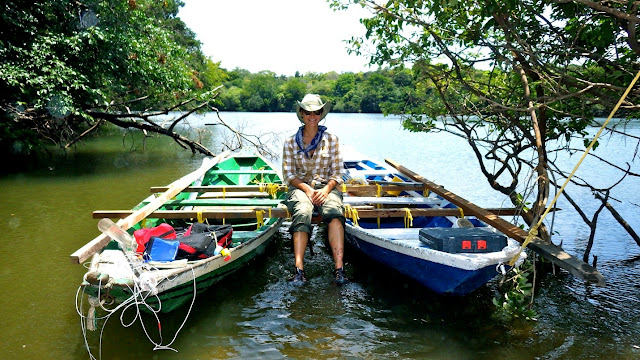Insights from Pre-Columbian Land Use and Fire Management in the Amazon Basin
by Yoshi Maezumi
Amazonia pristine or parkland? The great debate
Today our species stands on a precipice: From climate change to overpopulation, plastic pollution to wildfires, the modern human modus operandi is not sustainable. As international collaborative efforts join forces to develop strategic mitigation and adaptation plans to ferry our species through the 21st century [1, 2], scientists are looking to the past, seeking insights from indigenous land use practices around the world [3]. What has become evident is that the human footprint has had a much longer, more indelible impact than traditionally assumed, particularly in remote tropical regions like the Amazon Basin [3].
For much of the 20th century, the Amazon Basin was considered pristine wilderness prior to European Conquest in ca. 1492. Indigenous peoples (henceforth pre-Columbians) were thought to have had very little impact on the natural environment [4]. Yet, over the past few decades increased deforestation in the Amazon Basin began to reveal large archaeological sites in areas previously thought to be pristine [5–7]. These discoveries suggested that pre-Columbian peoples may have had a more substantial impact on the landscape and considerable debate has ensued [8–11]. Some researchers have argued for intensive local scale impacts [12] while others argue that the majority of the Amazon Basin is the remnant of an anthropogenic cultural parkland [5, 7]. To address this issue, an international team of archaeologists, palaeoecologists, botanists and palaeoclimatologists based at the University of Exeter, UK was assembled to explore the extent of pre-Columbian disturbance across the Amazon.
Amazonia pristine or parkland? The great debate
Today our species stands on a precipice: From climate change to overpopulation, plastic pollution to wildfires, the modern human modus operandi is not sustainable. As international collaborative efforts join forces to develop strategic mitigation and adaptation plans to ferry our species through the 21st century [1, 2], scientists are looking to the past, seeking insights from indigenous land use practices around the world [3]. What has become evident is that the human footprint has had a much longer, more indelible impact than traditionally assumed, particularly in remote tropical regions like the Amazon Basin [3].
For much of the 20th century, the Amazon Basin was considered pristine wilderness prior to European Conquest in ca. 1492. Indigenous peoples (henceforth pre-Columbians) were thought to have had very little impact on the natural environment [4]. Yet, over the past few decades increased deforestation in the Amazon Basin began to reveal large archaeological sites in areas previously thought to be pristine [5–7]. These discoveries suggested that pre-Columbian peoples may have had a more substantial impact on the landscape and considerable debate has ensued [8–11]. Some researchers have argued for intensive local scale impacts [12] while others argue that the majority of the Amazon Basin is the remnant of an anthropogenic cultural parkland [5, 7]. To address this issue, an international team of archaeologists, palaeoecologists, botanists and palaeoclimatologists based at the University of Exeter, UK was assembled to explore the extent of pre-Columbian disturbance across the Amazon.
 |
| Conducting fieldwork in the Alter do Chão, Brazil |
Testing the Pristine Hypothesis
Our research has provided new insights into the nature and legacy of past human land use on modern forest ecosystems. Our findings suggest that pre-Columbians utilized a complex system of fire management and land use over the past 4000 years in the eastern Amazon. Implementing low-level fire management (i.e. fires that barely heat up the soil and kill overstory vegetation) to clear land, pre-Columbian peoples relied on a combination of polyculture (planting multiple crop species) and agroforestry (enrichment of edible tree species). Around 2000 years ago, there was an increase in the development of nutrient rich anthropogenic soils known as Amazonian Dark Earth soils (ADEs; traditionally called terra preta do indio). These ADE soils were associated with crop cultivation and likely enabled the expansion and intensification of crop subsistence yields to feed the increasing pre-Columbian populations in the eastern Amazon region. Over four millennia of pre-Columbian fire management has had a lasting impact on the modern composition and structure of forests now growing on ADE soils in the eastern Amazon [13]. Our results demonstrate that the land use strategy combining fire management, crop cultivation, forest enrichment and soil amelioration that was employed by pre-Columbian peoples altered the forests associated with ADE soils. The use of frequent, low-severity fires over the past 4000 years reduced fire intolerant seed banks, progressively making forests associated with ADE soils more drought sensitive and fire prone [14].
Contextualizing modern fire
In 1974, the FLONA Reserve was created which installed a fire suppression policy as well as relocated traditional populations who still used fires as a landscape management tool. These fire suppression efforts have eliminated the benefits behind frequent fire activity in ADE forests which help reduce understory vegetation and fuel loads. Despite suppression efforts, wildfire activity and fire severity (amount of biomass burned) in the past decade is higher than any other period in our
4000-year record. This is attributed to combined climate and human factors which create optimal conditions for “mega-fires” (fires that burn more than 100,000 acres) in ADE forests. These new mega-fires threaten to transform the Amazon from a net carbon sink to a net carbon source. To help mitigate the occurrence of mega-fires, a fire management policy implementing low-severity fires similar to that employed by pre-Columbians and careful fire management for farming may help to reduce fuel loads (the amount of vegetation consumed by fires) and the occurrence and spread of mega-fires in the region.
Implications of our research
By implementing a multiproxy, interdisciplinary approach, it is possible to start teasing out the natural and anthropogenic drivers of past environmental change. This research has simulated a wealth of new research questions related to ecosystem adaptation, resilience, and recovery under long-term climate variability and different human land management strategies.
As both natural and anthropogenic pressures are projected to increase in the Amazon Basin, our data provide valuable new insights into the vital role that indigenous land management practices played in shaping modern ADE forest composition, structure, and flammability that can inform future management efforts in the eastern Amazon.
S. Yoshi Maezumi Ph.D.
Lecturer, Department of Geography and Geology, University of the West Indies, Jamaica
If you have questions or comments concerning Yoshi's post, please leave a comment below, or send her an email. You can also connect with her on Twitter.
_____________________________________________________
[1] T. W. V. Masson-Delmotte, P. Zhai, H. O. Pörtner, D. Roberts, J. Skea, P.R. Shukla, A. Pirani, W. Moufouma-Okia, C. Péan, R. Pidcock, S. Connors, J. B. R. Matthews, Y. Chen, X. Zhou, M. I. Gomis, E. Lonnoy, T. Maycock, M. Tignor, “Global warming of 1.5°C. An IPCC Special Report on the impacts of global warming of 1.5°C above pre-industrial levels and related global greenhouse gas emission pathways, in the context of strengthening the global response to the threat of climate change,” (Geneva, Switzerland, 2018).
[2] USGCRP, “Climate Science Special Report: Fourth National Climate Assessment, Volume I” (U.S. Global Change Research Program, Washington, DC, USA, 2017), doi:10.7930/J0J964J6.
[3] P. Roberts, C. Hunt, M. Arroyo-Kalin, D. Evans, N. L. Boivin, The deep human prehistory of global tropical forests and its relevance for modern conservation. Nat. Plants, 1–9 (2017).
[4] B. J. Meggers, Environmental limitation on the development of culture. Am. Anthropol. 56, 801–824 (1954).
[5] C. L. Erickson, Pre-Columbian roads of the Amazon. Expedition. 43, 21–30 (2001).
[6] C.L. Erickson, in The Handbook of South American Archaeology, H. Silverman, W. H. Isbell, Eds. (Springer, New York, NY, 2008).
[7] M. J. Heckenberger et al., Amazonia 1492: pristine forest or cultural parkland? Science. 301, 1710–4 (2003).
[8] C. R. Clement et al., The domestication of Amazonia before European conquest. Proc. R. Soc. London B Biol. Sci. 282 (2015).
[9] C. H. McMichael, K. J. Feeley, C. W. Dick, D. R. Piperno, M. B. Bush, Comment on “Persistent effects of pre-Columbian plant domestication on Amazonian forest composition.” Science (80-. ). 358, 1–2 (2017).
[10] C. Levis et al., Persistent effects of pre-Columbian plant domestication on Amazonian forest composition. Science (80-. ). 355, 925–931 (2017).
[11] A. B. Junqueira et al., Response to Comment on “Persistent effects of pre-Columbian plant domestication on Amazonian forest composition.” Science (80-. ). 358, 1–2 (2017).
[12] M. B. Bush et al., A 6900-year history of landscape modification by humans in lowland Amazonia. Quat. Sci. Rev. 141, 52–64 (2016).
[13] S. Y. Maezumi et al., The legacy of 4,500 years of polyculture agroforestry in the eastern Amazon. Nat. Plants (2018), doi:https://doi.org/10.1038/s41477-018-0205-y.
[14] S. Y. Maezumi et al., New insights from pre-Columbian land use and fire management in Amazonian Dark Earth forests. Front. Ecol. Evol. (2018).
[15] M. W. Palace et al., Ancient Amazonian populations left lasting impacts on forest structure. Ecosphere. 8, e02035--n/a (2017).
Our research has provided new insights into the nature and legacy of past human land use on modern forest ecosystems. Our findings suggest that pre-Columbians utilized a complex system of fire management and land use over the past 4000 years in the eastern Amazon. Implementing low-level fire management (i.e. fires that barely heat up the soil and kill overstory vegetation) to clear land, pre-Columbian peoples relied on a combination of polyculture (planting multiple crop species) and agroforestry (enrichment of edible tree species). Around 2000 years ago, there was an increase in the development of nutrient rich anthropogenic soils known as Amazonian Dark Earth soils (ADEs; traditionally called terra preta do indio). These ADE soils were associated with crop cultivation and likely enabled the expansion and intensification of crop subsistence yields to feed the increasing pre-Columbian populations in the eastern Amazon region. Over four millennia of pre-Columbian fire management has had a lasting impact on the modern composition and structure of forests now growing on ADE soils in the eastern Amazon [13]. Our results demonstrate that the land use strategy combining fire management, crop cultivation, forest enrichment and soil amelioration that was employed by pre-Columbian peoples altered the forests associated with ADE soils. The use of frequent, low-severity fires over the past 4000 years reduced fire intolerant seed banks, progressively making forests associated with ADE soils more drought sensitive and fire prone [14].
 |
| A conceptual figure of fire management and land use at the apex of Pre-Columbian occupation (modified from 12) |
Contextualizing modern fire
In 1974, the FLONA Reserve was created which installed a fire suppression policy as well as relocated traditional populations who still used fires as a landscape management tool. These fire suppression efforts have eliminated the benefits behind frequent fire activity in ADE forests which help reduce understory vegetation and fuel loads. Despite suppression efforts, wildfire activity and fire severity (amount of biomass burned) in the past decade is higher than any other period in our
 |
| A conceptual diagram of the change in fire management in the eastern Amazon taken from 13. |
Implications of our research
By implementing a multiproxy, interdisciplinary approach, it is possible to start teasing out the natural and anthropogenic drivers of past environmental change. This research has simulated a wealth of new research questions related to ecosystem adaptation, resilience, and recovery under long-term climate variability and different human land management strategies.
As both natural and anthropogenic pressures are projected to increase in the Amazon Basin, our data provide valuable new insights into the vital role that indigenous land management practices played in shaping modern ADE forest composition, structure, and flammability that can inform future management efforts in the eastern Amazon.
S. Yoshi Maezumi Ph.D.
Lecturer, Department of Geography and Geology, University of the West Indies, Jamaica
If you have questions or comments concerning Yoshi's post, please leave a comment below, or send her an email. You can also connect with her on Twitter.
_____________________________________________________
References:
[2] USGCRP, “Climate Science Special Report: Fourth National Climate Assessment, Volume I” (U.S. Global Change Research Program, Washington, DC, USA, 2017), doi:10.7930/J0J964J6.
[3] P. Roberts, C. Hunt, M. Arroyo-Kalin, D. Evans, N. L. Boivin, The deep human prehistory of global tropical forests and its relevance for modern conservation. Nat. Plants, 1–9 (2017).
[4] B. J. Meggers, Environmental limitation on the development of culture. Am. Anthropol. 56, 801–824 (1954).
[5] C. L. Erickson, Pre-Columbian roads of the Amazon. Expedition. 43, 21–30 (2001).
[6] C.L. Erickson, in The Handbook of South American Archaeology, H. Silverman, W. H. Isbell, Eds. (Springer, New York, NY, 2008).
[7] M. J. Heckenberger et al., Amazonia 1492: pristine forest or cultural parkland? Science. 301, 1710–4 (2003).
[8] C. R. Clement et al., The domestication of Amazonia before European conquest. Proc. R. Soc. London B Biol. Sci. 282 (2015).
[9] C. H. McMichael, K. J. Feeley, C. W. Dick, D. R. Piperno, M. B. Bush, Comment on “Persistent effects of pre-Columbian plant domestication on Amazonian forest composition.” Science (80-. ). 358, 1–2 (2017).
[10] C. Levis et al., Persistent effects of pre-Columbian plant domestication on Amazonian forest composition. Science (80-. ). 355, 925–931 (2017).
[11] A. B. Junqueira et al., Response to Comment on “Persistent effects of pre-Columbian plant domestication on Amazonian forest composition.” Science (80-. ). 358, 1–2 (2017).
[12] M. B. Bush et al., A 6900-year history of landscape modification by humans in lowland Amazonia. Quat. Sci. Rev. 141, 52–64 (2016).
[13] S. Y. Maezumi et al., The legacy of 4,500 years of polyculture agroforestry in the eastern Amazon. Nat. Plants (2018), doi:https://doi.org/10.1038/s41477-018-0205-y.
[14] S. Y. Maezumi et al., New insights from pre-Columbian land use and fire management in Amazonian Dark Earth forests. Front. Ecol. Evol. (2018).
[15] M. W. Palace et al., Ancient Amazonian populations left lasting impacts on forest structure. Ecosphere. 8, e02035--n/a (2017).


If the pre-Columbian tribes of the Amazon were nomadic and there are evidences that once the crops are abandon, the areas are recover by the autochthonous plants and trees, in what degree is this theory sustainable?While pre-Columbian may have preferred species by fire-stick control, dominant ecology may come by mean of the species character, such as for instance the Norway Spruce, invasive spice in North America. I mean, we can burn all Norway spruces of an area to favour Sugar Maple but once the intervention stop is taken back again by Norway Spruce. The other arguable concept is black soils and the presence of pottery artifacts. The Charruas tribes for instance in the costs of Rio De la Plata also leave remains of pottery artifact in places but soils where not necessary rich black, so how to relate one with the other?
ReplyDeleteHi Pablo
ReplyDeleteGreat questions. It is important to remember that both of the studies I summarized for the blog post are from the Santarem region. The area was one of the most densely populated areas in the Amazon Basin at the height of pre-Columbian occupation and one of the reasons why are team wanted to explore that area. We are particularly interested in developing a tool kit to detect pre-Columbian land use. What is important to note here is that we are not talking about nomadic tribes just passing through, we have palaeoecological and archaeological evidence indicating people were there for more than 4.000 years, practicing fire management, agroforestry, and crop cultivation. Our data show that at these kind of temporal scales, we do see a persistent legacy in modern forests. Additional lines of evidence which support this include ADE sites that we abandoned at contact (500 years ago). They continue to show disturbance effects from pre-Columbian land use. Now this is not to say that in another 500 years forests will not return to a more "old growth" types state, but as of now, we can measure significant differences in composition and structure of these forests.
Regarding your question about areas not related to ADEs (black earths), these are very different kinds of land use practices and extensive interdisciplinary studies like I summarized here, have not been published in many of these regions yet. I would hypothesize however, that where you have less disturbance (e.g. limited soil amelioration), there will be less impacts to forest composition and structure.